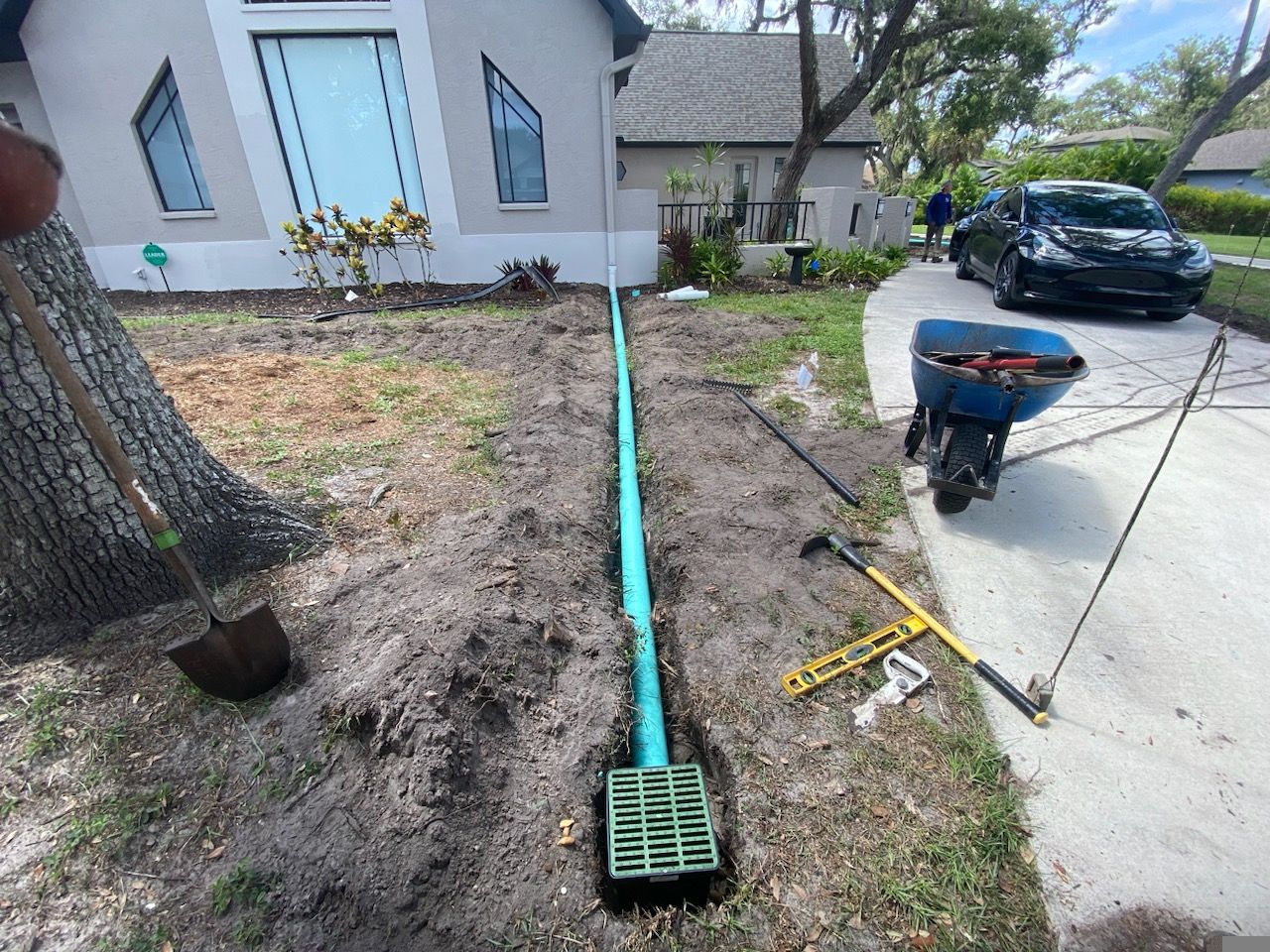If your garden is often soggy, waterlogged, or prone to pooling after heavy rainfall, it can cause numerous issues—from plant damage to soil erosion. Proper drainage is key to preventing these problems and maintaining a healthy, thriving garden. Fortunately, there are several effective garden drainage solutions that can help keep your outdoor space dry, no matter how wet the weather gets.
Here’s a guide to the best drainage solutions for wet gardens, ensuring your plants stay healthy and your outdoor space remains dry and usable.
1. French Drains: Redirect Excess Water Efficiently
A French drain is one of the most common and effective drainage solutions for wet gardens. It involves digging a trench, filling it with gravel, and installing a perforated pipe that allows water to flow through and be redirected to a safe location, such as a soakaway or storm drain. French drains are ideal for areas where water tends to collect and need to be moved away quickly.
Why it works:
- Redirects water away from garden beds and prevents pooling.
- Effective for gardens with poorly draining soil or low-lying areas.
- Can be customized to fit the size and layout of your garden.
Best for: Gardens with consistent water accumulation, areas with heavy clay soil, or spots that tend to collect rainwater.
2. Soakaways: Absorbing Water Underground
A soakaway is an underground drainage system designed to collect and absorb excess water into the ground. Soakaways consist of a pit or chamber filled with materials such as gravel or perforated crates that allow water to seep out and be absorbed by the surrounding soil. This is an excellent solution for gardens where surface drainage might be difficult.
Why it works:
- Provides an eco-friendly way to absorb water rather than sending it offsite.
- Helps reduce the risk of waterlogging by allowing the soil to gradually absorb excess moisture.
- Ideal for gardens with limited space for above-ground drainage solutions.
Best for: Gardens with heavy clay soil or areas with limited surface space for drains.
3. Swales: Natural Channels for Water Flow
A swale is a shallow trench or depression that is designed to collect and redirect water away from garden beds and paths. Swales are typically planted with grass or other vegetation, which helps to slow down the flow of water and allows it to be absorbed into the soil. They are an effective, natural way to manage water in sloped or uneven gardens.
Why it works:
- Reduces surface water runoff and erosion by allowing water to be absorbed slowly.
- Promotes a more natural water flow that works with the garden’s landscape.
- Low-maintenance and cost-effective solution.
Best for: Gardens with slopes or areas where water naturally runs off and pools.
4. Permeable Paving: Allow Water to Flow Through
In areas where you have hard surfaces such as driveways, patios, or walkways, permeable paving can help reduce water runoff and improve drainage. Permeable paving materials allow rainwater to filter through the surface and be absorbed by the soil below, reducing the chances of puddles forming around your garden beds or pathways.
Why it works:
- Allows rainwater to soak into the ground, reducing surface runoff.
- Helps prevent flooding in paved areas while allowing plants to access the water they need.
- Sustainable and low-maintenance option for hard surfaces.
Best for: Patios, driveways, or garden paths where water runoff is a problem.
5. Surface Water Drains: Capture and Channel Rainwater
If you have paved areas or garden beds that tend to accumulate water, surface water drains can capture excess rainwater and direct it to a designated drainage system or soakaway. These drains typically consist of grated channels or slot drains installed along garden borders, patios, or paths to capture and redirect water.
Why it works:
- Quickly channels water away from garden beds, preventing waterlogging.
- Easy to install and maintain, especially in areas with persistent pooling.
- Ideal for areas where water collects due to poor natural drainage.
Best for: Patios, pathways, or garden beds where surface water is a recurring issue.

6. Raised Garden Beds: Elevating Plants for Better Drainage
If your garden soil is prone to staying wet, raised garden beds are an excellent way to elevate your plants above soggy ground. By raising the growing area, water can drain away more easily, preventing root rot and creating a healthier environment for your plants. Raised beds also offer better control over the quality of the soil, allowing you to amend it for optimal drainage.
Why it works:
- Prevents excess water from accumulating around plant roots.
- Improves soil aeration and drainage.
- Keeps plants drier during periods of heavy rainfall, promoting better root health.
Best for: Gardens with heavy, poorly-draining soil or areas prone to waterlogging.
7. Gutter and Downspout Extensions: Protect Your Garden from Roof Runoff
Water runoff from your roof can contribute significantly to waterlogging around the foundation of your home and in garden beds. Installing gutter and downspout extensions can help direct rainwater further away from your garden, preventing it from soaking into your flower beds or lawn. This solution is simple to implement and helps protect both your home’s foundation and your garden.
Why it works:
- Prevents water from pooling near the base of your garden beds or home.
- Reduces the risk of waterlogging around plant roots.
- Protects the integrity of your garden’s structure by channeling water safely away.
Best for: Homes where water runoff from the roof is contributing to garden flooding or waterlogging.
8. Aeration: Improve Soil Drainage Naturally
Soil compaction can make it difficult for water to drain effectively, leading to pooling and waterlogging. Using a soil aerator to puncture small holes in the soil can help break up compacted areas, allowing water to flow more freely and oxygen to reach plant roots. Aeration improves overall soil health and prevents water from accumulating on the surface.
Why it works:
- Increases water infiltration and reduces the likelihood of surface water runoff.
- Improves root health by allowing oxygen and nutrients to reach the roots more effectively.
- Helps prevent the formation of puddles and waterlogged areas.
Best for: Gardens with compacted soil, especially those with heavy clay or loam.
9. Sump Pumps: A Backup Plan for Severe Waterlogging
In areas prone to heavy rainfall or frequent flooding, a sump pump system can be an effective way to remove excess water from your garden. Sump pumps are installed in a pit, collecting water from around the garden, and pumping it out of the area to prevent flooding. This solution is ideal for gardens with extreme waterlogging issues.
Why it works:
- Provides an emergency solution for flood-prone areas or gardens at risk of standing water.
- Quickly removes large amounts of water from the garden, protecting plants and garden structures.
- Helps maintain a dry and healthy garden, even during periods of intense rainfall.
Best for: Gardens that experience frequent flooding or are located in areas with a high water table.
Conclusion
Waterlogging doesn’t have to ruin your garden. With the right drainage solutions in place, you can keep your outdoor space dry, healthy, and vibrant, even during heavy rains. From French drains and soakaways to permeable paving and raised beds, these drainage systems offer simple, effective ways to combat wet garden conditions. Choose the solution that works best for your garden.
